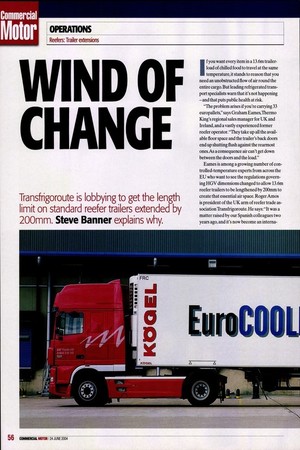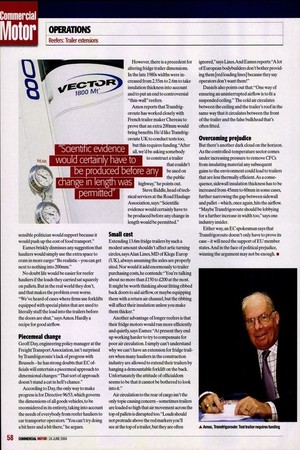11111141:1 OF CHANGE Transfrigoroute is lobbying to get the length limit on standard reefer trailers extended by
Page 58

Page 59

Page 60

If you've noticed an error in this article please click here to report it so we can fix it.
200mm. Steve Banner explains why.
If you want every item in a 13.6m trailerload of chilled food to travel at the same temperature, it stands to reason that you need an unobstructed flow of air round the entire cargo. But leading refrigerated transport specialists warn that it's not happening — and that puts public health at risk.
If you want every item in a 13.6m trailerload of chilled food to travel at the same temperature, it stands to reason that you need an unobstructed flow of air round the entire cargo. But leading refrigerated transport specialists warn that it's not happening — and that puts public health at risk.
If you want every item in a 13.6m trailerload of chilled food to travel at the same temperature, it stands to reason that you need an unobstructed flow of air round the entire cargo. But leading refrigerated transport specialists warn that it's not happening — and that puts public health at risk.
"The problem arises if you're carrying 33 europallets," says Graham Eames,Thermo King's regional sales manager for UK and Ireland, and a vastly experienced former reefer operator. "They take up all the available floor space and the trailer's back doors end up shutting flush against the rearmost ones. As a consequence air can't get down between the doors and the load." Eames is among a growing number of controlled-temperature experts from across the EU who want to see the regulations governing HGV dimensions changed to allow 13.6m reefer trailers to be lengthened by 200mm to create that essential air space. Roger Amos is president of the UK arm of reefer trade association Transfrigoroute. He says: "It was a matter raised by our Spanish colleagues two years ago, and it's now become an interna
tional initiative." But why all the fuss over a mere 200mm? "If you don't get a proper air flow you risk having hot spots in various places throughout the load," Eames warns. Mark Daniels, UK technical manager at Carrier Transicold, reports: "When product is International initiative rejected by supermar kets, 85 % of the time
it's because there was an airflow problem or because the trailer was loaded incorrectly."
Eames adds: "A lot of foodstuffs are carried at +2-5°C, which means that the temperature doesn't have to rise all that much to reach +8°C —the perfect temperature for listeria bacteria to breed. Remember too that a lot of the UK's food is imported under temperature-controlled conditions, and it comes in on europallets." That's why Transfrigoroute is lobbying the EU's Health and Consumer Protection Direc
torate-General hard for a change in the length laws.And it believes the Energy and Transport Directorate-General will be more responsive to making a change if the Health DirectorateGeneral accepts the argument and picks up the cudgels on Ransfrigoroute's behalf.
However,Amos admits that so far the reefer trade association's argument has received a cool reception from the Brussels bureaucrats: "I think our chances are good, but it could take three to five years to get the law changed. It's a highly political issue —nobody wants to be seen to be endorsing 'bigger juggernauts' — but we can of course advance the argument that a change would benefit public health. In the UK we've approached both the Department for Transport and the Department of Health, and the latter has acknowledged that we may have a point." One obvious way to solve the problem would be to restrict the number of europallets carried on a reefer trailer.A limit of 30, for example, would leave room at the back for air to circulate. But Eames says: "If hauliers did that they'd be running inefficiently."And Amos points out: "That's not something any
sensible politician would support because it would push up the cost of food transport."
Eames briskly dismisses any suggestion that hauliers would simply use the extra space to cram in more cargo: "Be realistic — you can get next to nothing into 200mm."
No doubt life would be easier for reefer hauliers if the loads they carried sat squarely on pallets But in the real world they don't, and that makes the problem even worse. "We've heard of cases where firms use forklifts equipped with special plates that are used to literally stuff the load into the trailers before the doors are shut," says Amos. Hardly a recipe for good airflow. Piecemeal change
Geoff Day, engineering policy manager at the Freight Transport Association, isn't surprised by Transfrigoroute's lack of progress with Brussels —he has strong doubts that EC officials will entertain a piecemeal approach to dimensional changes: "That sort of approach doesn't stand a cat in hell's chance."
According to Day, the only way to make progress is for Directive 96/53, which governs the dimensions of all goods vehicles, to be reconsidered in its entirety, taking into account the needs of everybody from reefer hauliers to car transporter operators. "You can't try doing a bit here and a bit there," he argues.
However, there is a precedent for altering fridge trailer dimensions In the late 1980s widths were increased from 2.55m to 2.6m to take insulation thickness into account and to put an end to controversial "thin-wall" reefers. Amos reports that Transfrigoroute has worked closely with French trailer maker Chereau to prove that an extra 200mm would bring benefits. He'd like Transfrig
oroute UK to conduct tests too, but this requires funding."After all, we'd be asking somebody to construct a trailer that couldn't be used on the public highway," he points out.
oroute UK to conduct tests too, but this requires funding."After all, we'd be asking somebody to construct a trailer that couldn't be used on the public highway," he points out.
oroute UK to conduct tests too, but this requires funding."After all, we'd be asking somebody to construct a trailer that couldn't be used on the public highway," he points out.
oroute UK to conduct tests too, but this requires funding."After all, we'd be asking somebody to construct a trailer that couldn't be used on the public highway," he points out.
Steve Biddle, head of technical services at the Road Haulage Association, says: "Scientific evidence would certainly have to be produced before any change in length would be permitted."
Steve Biddle, head of technical services at the Road Haulage Association, says: "Scientific evidence would certainly have to be produced before any change in length would be permitted." Small cost
Extending 13.6m fridge trailers by such a modest amount shouldn't affect artic turning circles, says Alan Lines, MI) of Klege Europ (UK), always assuming the axles are properly sited. Nor would it add enormously to trailer purchasing costs, he contends: "You're talking about no more than £150 to £200 at the most. It might be worth thinking about fitting ribbed back doors to aid airflow, or maybe equipping them with a return air channel, but the ribbing will affect their insulation unless you make them thicker."
Another advantage of longer reefers is that their fridge motors would run more efficiently and quietly, says Eames:"At present they end up working harder to try to compensate for poor air circulation. I simply can't understand why we can't have an extension for fridge trailers when many hauliers in the construction industry are allowed to extend their trailers by hanging a demountable forklift on the back. Unfortunately the attitude of officialdom seems to be that it cannot be bothered to look into it." Air circulation to the rear of cargo isn't the only topic causing concern—sometimes trailers are loaded so high that air movement across the top of pallets is disrupted too. "Loads should not protrude above the red markers you'll see at the top of a trailer,but they are often
ignored," says Lines.And Eames reports: "A lot of European bodybuilders don't bother providing them [red loading lines] because they say operators don't want them!"
Daniels also points out that:" One way of ensuring an uninterrupted airflow is to fit a suspended ceiling." The cold air circulates between the ceiling and the trailer's roof in the same way that it circulates between the front of the trailer and the false bulkhead that's often fitted. Overcoming prejudice
But there's another dark cloud on the horizon. As the controlled-temperature sector comes under increasing pressure to remove CFCs from insulating material any subsequent gains to the environment could lead to trailers that are less thermally efficient. As a consequence, sidewall insulation thickness has to be increased from 45mm to 60mm in some cases, further narrowing the gap between sidewall and pallet — which, once again, hits the airflow. "Maybe Transfrigoroute should be lobbying for a further increase in width too," says one industry insider. Either way, an EC spokesman says that Transfrigoroute doesn't only have to prove its case —it will need the support of EU member states.And in the face of political prejudice, winning the argument may not be enough. •


































































































































































































